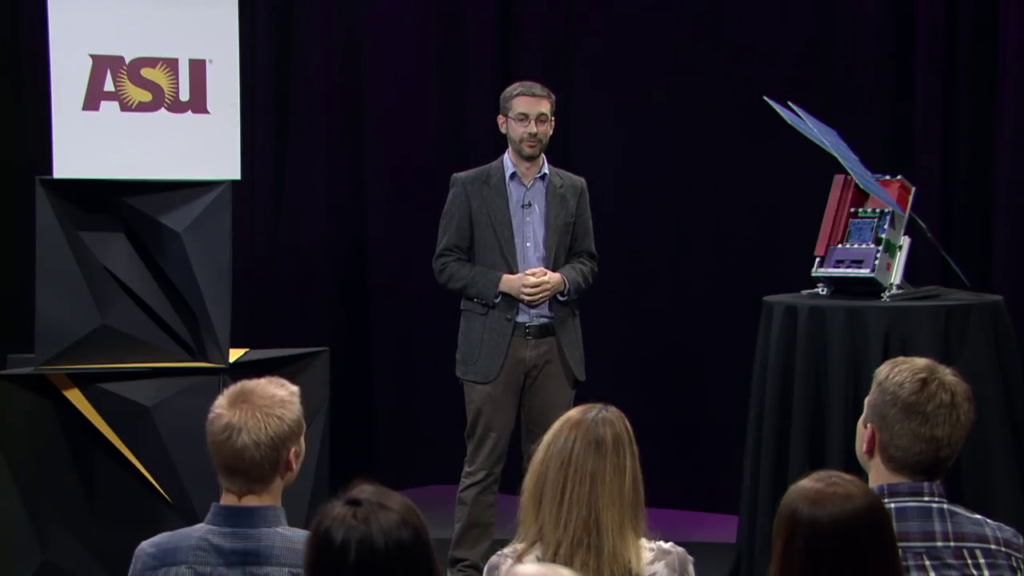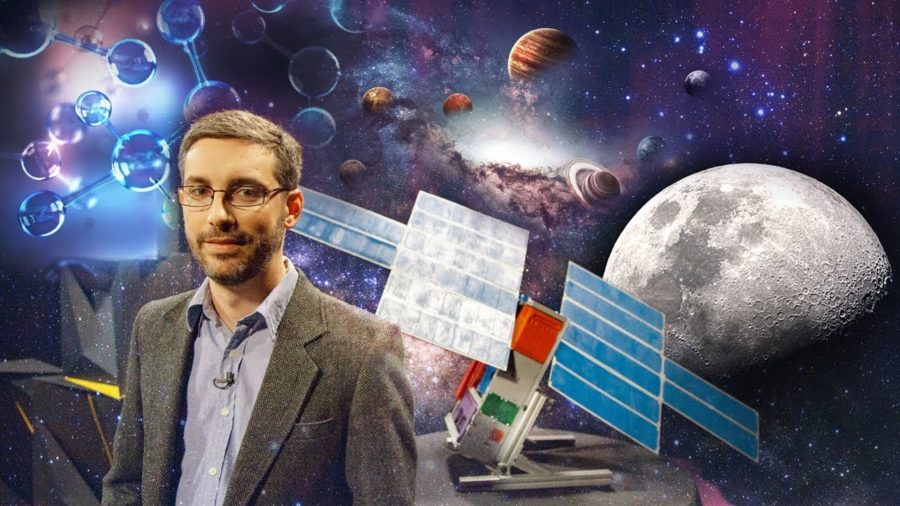Craig Hardgrove: Hi. I’m Craig Hardgrove and I’m leading a team of researchers that’s sending this spacecraft to the moon.

This isn’t a scaled-down version. This is the actual size of our spacecraft. It’s called the Lunar Polar Hydrogen Mapper, or LunaH-Map for short. LunaH-Map will launch on one of the most powerful rockets ever built by NASA. And this tiny spacecraft will propel itself into lunar orbit using its own propulsion system. And that’s a first for a spacecraft this small. As with any first, it’s also very risky. I want to tell you about this mission, why we’re going to the moon, and why it’s worth the risk.
We’re sending LunaH-Map to the moon to sniff out just how much hydrogen is beneath the surface. And we’re looking for hydrogen because it’s a key component of water. Water is geologically interesting on the moon. How did it get there? It’s also important for future human exploration, since it could be used as fuel. The moon could be a jumping-off point for the rest of the solar system. But the moon is a harsh place. It barely has any atmosphere at all. The temperature can change by more than 100 degrees from day to night. And in that type of environment, any ice or water that’s hit by sunlight would immediately be lost to space.
But there’s a lot of scientific evidence that suggests water ice could be present on the moon, but in special eternally-dark crater floors at the South Pole. These regions are in permanent shadow. They’re some of the coldest places in the entire solar system. So that’s where LunaH-Map map is headed. LunaH-Map will carry a tiny science instrument called a neutron detector, which is sensitive to the low-energy neutrons that are leaking out at the top meter of the moon’s surface. We can use that total number of neutrons to determine how much hydrogen is trapped below. And that too is something that’s never before been attempted on a spacecraft this small.
But in order to improve upon the previous measurements of ice at the moon’s South Pole, LunaH-Map needs to get very close. Really really close. It turns out we need to be about thirty thousand feet above the surface of the moon, which is the typical cruising altitude for a commercial airplane. And we need to make our measurements while orbiting over the moon at about four thousand miles per hour. And that’s eight times faster than your typical commercial airplane. All of this, you guessed it, is a first for a spacecraft this small.
So you might reasonably wonder where an audacious idea like a shoebox-sized spacecraft capable of doing all these things came from. About ten years ago a university professor wanted to come up with class projects for his engineering students. The idea was to have them build small, functional bench-top components that might be used on a spacecraft. But with the added engineering challenge of making them fit into a very tiny box. These were just student learning tools and demonstrations. So when thinking about the dimensions of his tiny box, he decided on a Beanie Baby box: ten centimeters by ten centimeters by ten centimeters. He called them CubeSats. Surely he thought, something this small would never fly into space and never actually do anything useful.
But as a student training exercise, they were perfect. The idea of CubeSats was a success. Universities across the country adopted CubeSats. And they became a successful teaching tool and development platform. Perhaps a little too successful. Because piece by piece, over the last ten years the components that make up LunaH-Map have been developed at or in partnership with universities, their faculty, their students, and staff. Over the years if students were lucky enough, their CubeSats would be launched into low-Earth orbit to test their designs in space. And they wound up not just testing designs but developing new, miniaturized spacecraft technologies.
Eventually, university students developed radios, instruments, reaction wheels, propulsion systems, and many other components. Until someone asked a really good question: don’t all these components put together make up an interplanetary spacecraft? And they do. As long as we accept the inherent risk of using any new technology. Take a different industry from our own lives, for example: smartphones. No one gives up on smartphones entirely if there are bugs in the first version. New technology always improves over time, but the first version is a little risky. And there’s a funny thing that happens when you start accepting risk and accepting a lot of it. With a risky spacecraft, you can do risky things. Things you wouldn’t normally do on a typical big NASA mission that takes decades to design, build, and fly. Think about it. Would you risk your spacecraft after a decade of work? It’s not likely. But with shorter development times, smaller teams, lower costs, it actually allows you to embrace risk, and hopefully reap the rewards. In fact I’d argue that this is fundamental to what makes tiny missions like these worth doing.
You may remember probe droids from Star Wars. Expendable robots deployed to capture unique, hard-to-get data about say a rebel base. Imagine if we had a dozen or more tiny probes on every NASA mission. They could fly low over the icy surface of Europa, transmit valuable data from the atmosphere of Venus on descent, just before being crushed by the intense atmospheric pressure. These probes can act as interplanetary scouts, deploying from a primary spacecraft, maneuvering to intersect with asteroids that no spacecraft has ever before visited. And these are just a few examples of the type of risky but highly-rewarding missions that these tiny probes might take on as we venture out further into the solar system.
Now risk is a part of all of our lives. And it can be scary. But very few rewards come without risk. Personally I chose to pursue this mission as a post-doc at ASU. It’s uncommon to give a moon mission to someone who is essentially fresh out of their PhD. But despite the risks, I put everything I had into it, I devoted many months of pulling together our team and working on the proposal. And our team despite the risks put everything they had into it too. I’ll be honest we all knew the chances of success were low. And the risk of failing was high. But the rewards were even higher. And that’s what kept and keeps us going.
It should sound familiar: high risk, high reward. The concept of these tiny spacecraft is something that we all truly believe in. It represents a vision of a future world that we want to live in, where space is more accessible than ever, and to many more people than ever before. And that makes the risk of working on LunaH-Map worth it. I wouldn’t have done anything else. And the best part is I get to lead this visionary team of people and work with colleagues every day who believe in it, too. Thanks.
